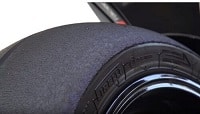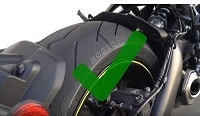Deprecated: mb_convert_encoding(): Handling HTML entities via mbstring is deprecated; use htmlspecialchars, htmlentities, or mb_encode_numericentity/mb_decode_numericentity instead in /home/u598013642/domains/motorcyclegear101.com/public_html/wp-content/themes/acabado/functions.php on line 2160
Deprecated: mb_convert_encoding(): Handling HTML entities via mbstring is deprecated; use htmlspecialchars, htmlentities, or mb_encode_numericentity/mb_decode_numericentity instead in /home/u598013642/domains/motorcyclegear101.com/public_html/wp-content/themes/acabado/functions.php on line 2160
Learn the best way to break in motorcycle tires with our detailed video guide.
What is the best way to break in motorcycle tires? Every tire manufacturer recommends a break-in period for new tires but here we’ll separate the facts from the myths. To answer the question what is the best way to break in motorcycle tires is to put some miles on them. But that is a simplistic answer as there is a little more to it than that.
Prefer to watch a video tutorial? Click here to watch our video.
In this article, we are going to take a look at the label on most new sets of tires. You’ll see a warning that suggests you should avoid sudden acceleration, maximum braking in hard cornering for the first 100 miles.
Those gentle initial miles you put on your new tires are known as the break-in period and they’re a good idea for a few reasons.
The first and most important reason is to scuff up the tread to develop traction. There are plenty of examples of people spinning out and low siding on new tires because fresh rubber tends to be a little bit slippery.

It’s not slippery because there’s grease on the tread, that is a common misconception that I will get to later. New tires tend to be slippery because, for one, the rubber is cold and two the new tread is very smooth and slick.
If you look at a used tire though, it’s a landscape of peaks and valleys, kind of like sandpaper. That rough texture actually provides quite a bit of mechanical grip by interlocking with the rough surface of the road and that rough finish on the tire can take quite a few miles to wear in.
How Many Miles To Break in Motorcycle Tires
So how far is far enough? That depends on the tires. If you’ve got a set of soft track tires that are fresh off the warmers they’re ready to go after just one lap around the racetrack.
Meanwhile, if you’ve got a set of heavy-duty touring tires they may take a hundred miles or more to break-in the tire. That’s because this is a pretty hard tread compound as these tires are designed to last for thousands of miles.
Most manufacturers recommend between a fifty and a hundred miles break-in period because that’s how long they assume it will take you to hit enough corners to scuff in the majority of the tire tread.
However, if you just put on a few miles in a straight line on the freeway and then bail into a corner expecting your tires to be gripping correctly, you’re probably in for a crash.

Tire break-in isn’t just a matter of distance or time, it’s the process by which you scuff in as much of the usable tire surface as possible.
My recommendation for breaking in new tires is to simply find a twisty road and start riding. Go gently at first gradually increase speed and lean angle, once you’ve got a dull finish across the tread as you see on this tire you’re good to go.
Should You Sandpaper New Motorcycle Tires
Using sandpaper on a set of new tires as an attempt to break them in is something I’ve heard suggested, and while it’s not exactly a bad idea it is a waste of time. Tires are tough and that sanding action isn’t nearly enough force or friction to roughen up the surface the way riding on it will.
Scrubbing in the tire surface is important for improving grip, but some folks still think that new tires are slick because they’re covered with something slippery from the factory.
It’s true back in the day manufacturers used to apply Lube to help the tires pop out of the molds but these days that’s just not the case, at least not for Pirelli and other upmarket brands.
Nowadays the molds are actually polished or they have an anti-stick coating, kind of like Teflon on a frying pan so there’s no lube needed. That Sheen you see on new tires is just the way fresh rubber looks when it comes out of the mold.
That said release agents are occasionally smeared on the sidewall area of the molds to ensure that the script and logos are crisp and legible, but no mainstream tire manufacturer puts anything slippery on the tread area of the tire.
The second reason to set aside some miles for break-in is to allow you as a rider to get used to the handling of your new rubber.
Different makes and models of tire have different profiles and carcass constructions and they’re going to behave differently out on the road.
Even if you installed a new set of the same tires you’ve been using they’re going to feel different. The old tires had a worn flat profile and the new tires have a round profile.
The third reason to give your tires at least a few miles of a break-in is to provide them with the opportunity to settle.
This isn’t really an issue with compliant radial tires, but some manufacturers say that the stiff bias-ply rubber found on vintage bikes cruisers and some touring rigs need some time for the bead to fully settle into the rim and for the various plies and materials in the carcass to settle out.
It’s arguably a topic for a separate article but I can’t talk about tire break-in and not talk about tire temperature.
Tire grip is affected by the texture which is why we scrub in new tires but the temperature is an even more important ingredient in the grip equation and it’s a factor every time you ride.
Those race tires I was talking about, they’re ready to grip because they’ve been baking at a hundred and seventy-five degrees on tire warmers and because they’re made from super sticky rubber that’s only meant to last for 20 laps.
Your street tires are a lot less specialized but it’s still very important to give them time to heat up before you start riding hard, even if your tires are already broken in.
Tires develop heat as a result of friction with the road and flex from tire load, and a good way to get them warmed up is with a few miles of riding that involves plenty of straight-line acceleration and braking.
Alright, there you have it. Our breakdown on tire break-in. Hopefully, that answered some questions and cleared up some misconceptions, but ultimately the takeaway here is that you should take it easy on those new tires.
Watch Video Tutorial
Previous Article: When To Change Motorcycle Tires
Next Article: Best Motorcycle Tires

